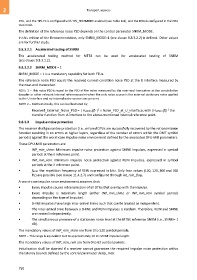Page 760 - 5G Basics - Core Network Aspects
P. 760
2 Transport aspects
DTU, and the TPS-TC is configured with TPS_TESTMODE enabled (see Table 8-8), and the DRA is configured in the DRA
test mode.
The definition of the reference noise PSD depends on the control parameter SNRM_MODE.
In this edition of the Recommendation, only SNRM_MODE=1 (see clause 9.8.3.2.2) is defined. Other values
are for further study.
9.8.3.2.1 Accelerated testing of SNRM
The accelerated testing method for MTBE can be used for accelerated testing of SNRM
(see clause 9.8.3.1.2).
9.8.3.2.2 SNRM_MODE = 1
SNRM_MODE = 1 is a mandatory capability for both FTUs.
The reference noise PSD equals the received current-condition noise PSD at the U interface measured by
the near-end transceiver.
NOTE 1 – This noise PSD is equal to the PSD of the noise measured by the near-end transceiver at the constellation
decoder or other relevant internal reference point when the only noise source is the external stationary noise applied
to the U interface and no internal noise sources are present.
NOTE 2 – Mathematically, this can be illustrated by:
2
2
Received_External_Noise_PSD = | HRXfilter(f) | Noise_PSD_at_U_interface, with |HRXfilter(f)| the
transfer function from U-interface to the above-mentioned internal reference point.
9.8.3.3 Impulse noise protection
The receiver shall guarantee protection (i.e., errored DTUs are successfully recovered by the retransmission
function resulting in no errors at higher layers, regardless of the number of errors within the DMT symbol
periods) against the worst-case impulse noise environment defined by the associated DPU-MIB parameters.
These DPU-MIB parameters are:
• INP_min_shine: Minimum impulse noise protection against SHINE impulses, expressed in symbol
periods at the reference point.
• INP_min_rein: Minimum impulse noise protection against REIN impulses, expressed in symbol
periods at the reference point.
• fREIN: the repetition frequency of REIN expressed in kHz. Only four values (100, 120, 300 and 360
Hz) are possible (see clause 11.4.2.7) and configured through iat_rein_flag.
A worst-case impulse noise environment assumes that:
• Every impulse causes retransmission of all DTUs that overlap with the impulse.
• Every impulse is maximum length (either INP_min_shine or INP_min_rein symbol periods
depending on the type of impulse).
• SHINE impulses have large inter-arrival times such that can be treated as independent.
• The inter-arrival time between a SHINE and REIN impulses is random. Therefore, REIN and SHINE
are treated independently.
• The simultaneous presence of a stationary noise level at the MTBE reference SNRM (i.e., SNRM= 1
dB).
The mandatory values of INP_min_shine are from 0 to 520 symbol periods.
NOTE – This range is equivalent to 0 to approximately 10 ms SHINE impulse length.
The mandatory values of INP_min_rein are from 0 to 63 symbol periods.
Initialization shall be aborted if a receiver cannot guarantee the required impulse noise protection within
the latency bounds defined by the control parameter delay_max.
750

